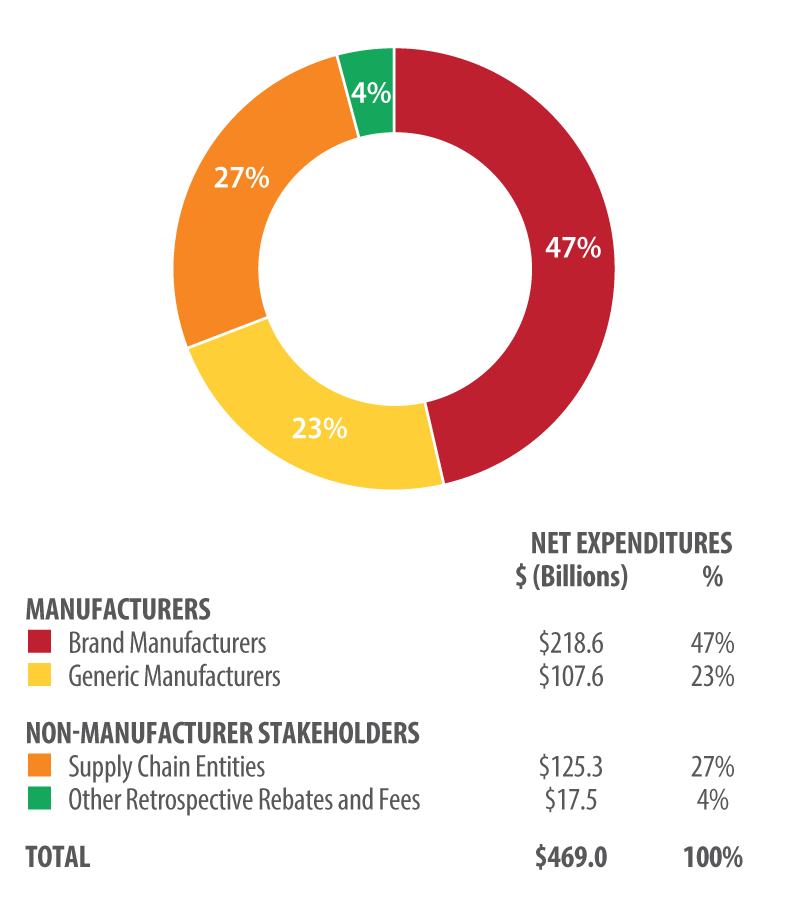US Drug Spending: Where Does All The Money Go?
Executive Summary
PhRMA has released new data on where gross and net drug expenditure ends up along the pharmaceutical supply chain, which will support its position the debate over US drug pricing.
As pressure has mounted on prescription drug pricing in the US, manufacturers have started to point the finger at other players along the supply chain. New data commissioned by the Pharmaceutical Research and Manufacturers of America (PhRMA) provides the evidence manufacturers need as the debate over drug pricing heats up.
During Congressional hearings last year on Mylan Pharmaceuticals Inc.‘s EpiPen, confusion reigned when CEO Heather Bresch tried to appoint some of the blame further down the supply chain. (Also see "How Many Pricing Hearings Add Up To Action On Pricing Transparency?" - Scrip, 22 Sep, 2016.) Biotechnology Innovation Organization Chairman and Acorda Therapeutics Inc. CEO Ron Cohen has also called for more transparency to reveal which players most benefit from price increases. (Also see "Bridging The Drug Price Divide: Ideas And Approaches Debated At PSA" - Scrip, 4 Oct, 2016.)
With the Pharmaceutical Supply Chain: Gross Drug Expenditures Realized By Stakeholders report by the Berkeley Research Group, PhRMA and its members have an unprecedented dataset showing what proportion of price increases go to the manufacturer’s bottom line, and what is passed down the chain.
The study reveals that negotiated health plan and pharmacy benefit manger rebates and fees have nearly doubled just since 2013, while drug makers realize a smaller percentage year after year of the average drug's list price. (Also see "Pharma's Middlemen Get Fatter: PBM, Health Plan Rebates Near $58bn" - Scrip, 19 Jan, 2017.)
The report attempts to clarify what exactly happens with drug expenditures with a pair of metrics:
- initial gross drug expenditures, or the sum of payments for pharmaceuticals made by patients and health plans at the point of sale, prior to any discount, rebate or fee provided by the manufacturer, and
- net drug expenditures, the actual, final cost of medicines after deducting the cost concessions that ostensibly reduce costs for patients and payers.
In 2015, brand name manufacturers realized only 39% of initial gross drug expenditures, the report notes. A larger share – 42% – went to payers and other supply chain entities, with price concessions accounting for an estimated 22% of the whole and statutory and negotiated rebates comprising about 20%.
Breakdown Of Initial Gross Drug Expenditures

Source: Berkeley Research Group
The graphic above shows initial gross drug expenditures divided by entity in 2015. While brand-name pharma took the largest share of any individual stakeholder in the supply chain, generic drug makers also account for 19% of the total. Meanwhile, supply chain participants, such as insurance plans, accounted for 22%. Retrospective rebates and discounts to payers and patients comprised 17% of the total, while other rebates and fees are estimated at 3%.
For net drug expenditures, BRG estimated an aggregate value of $469bn in the US for 2015. Of that total, brand-name manufacturers took in 47%, roughly $218.6bn, and generic firms realized 23%, approximately $107.6bn. Among non-manufacturer stakeholders, supply chain entities accounted for 27% of the net expenditure, $125.3bn, and other rebates and fees made up 4% of the total, or about $17.5bn. (See graphic below.)
Breakdown Of Net Drug Expenditures Source: Berkeley Research Group
The report adds that its estimates are roughly in line with $310bn in net drug spending realized by brand and generic drug makers in 2015, according to analysis published by IMS Health.
Between 2013 and 2015, the researchers found that brand manufacturers’ share of gross drug expenditures declined from 41% to 39%, while the share by non-manufacturers increased from 38% to 42%. “The largest driver in this trend is the increase in retrospective rebates and discounts paid to health plans, PBMs, and government payers by brand manufacturers, which largely offset increases to drug list prices and reflects the increasingly competitive marketplace for brand drugs,” the report states.
The increasingly larger payments for market access apply both with negotiated discounts with private-sector payers and as well as mandatory discounts and fees related to government health care programs such as Medicaid and Medicare Part D, the researchers note.
"Many of these discounts are not plainly visible, leading to misperceptions about the relative share of gross and net drug expenditures realized by brand manufacturers," they conclude. "An informed discussion about pharmaceutical spending and affordability must be supported by an understanding of the role played by all entities involved in the distribution and purchase of medicines and a recognition of the discounts that lead to far lower net spending than is commonly reported based on invoice price figures."
Pfizer Inc. CEO Ian Read has already been vocal about the role rebates play in obfuscating drug pricing. (Also see "Pfizer’s Read Criticizes Rebates Amid Changing Market Dynamics" - Scrip, 1 Nov, 2016.) With the data in hand from PhRMA and US President Trump clear that he intends to take on drug pricing, expect to see more biopharma CEOs taking up this refrain.
